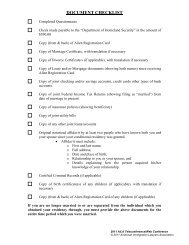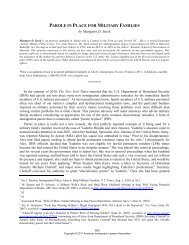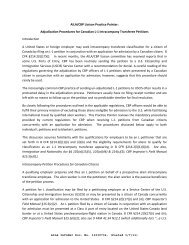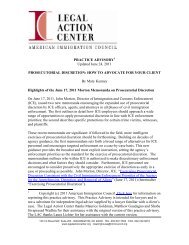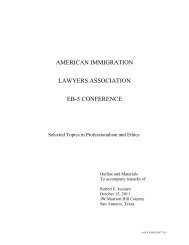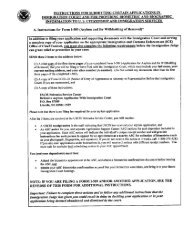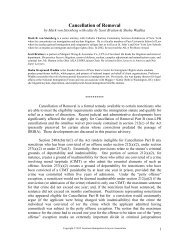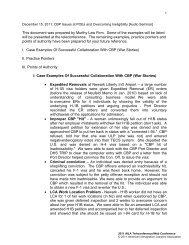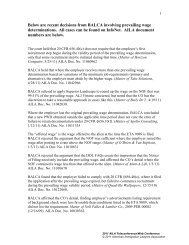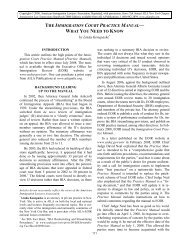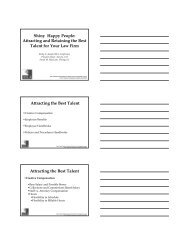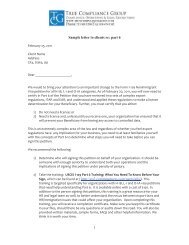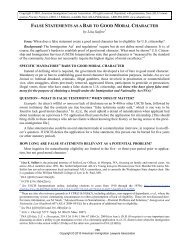Resources for 12-06-11 Seminar - AILA webCLE
Resources for 12-06-11 Seminar - AILA webCLE
Resources for 12-06-11 Seminar - AILA webCLE
Create successful ePaper yourself
Turn your PDF publications into a flip-book with our unique Google optimized e-Paper software.
1<br />
PERM Audits Are Coming Back—<br />
A Detailed Look at Some Specific Pitfalls to Avoid<br />
December 6, 20<strong>11</strong><br />
List of Cases and Materials Referenced in Presentation<br />
Speakers: Ester Greenfield, Sharryn Ross, Ron Wada<br />
Introduction – the Most Recent BALCA Decision<br />
Matter of Karl Storz Endoscopy, 20<strong>11</strong>-PER-00040 (<strong>12</strong>/1/20<strong>11</strong>) <strong>AILA</strong> Doc. No. <strong>11</strong><strong>12</strong>0264.<br />
Matter of Horizon Computer Services, 2010-PER-00746 ( 5/25/<strong>11</strong>) <strong>AILA</strong> Doc. No. <strong>11</strong><strong>06</strong>0962<br />
Matter of Quadrille Wallpapers & Fabrics, 2010-PER-68 (Dec. 15, 2010)<br />
Department of Labor Stakeholders Minutes, October 5, 20<strong>11</strong>, <strong>AILA</strong> Doc. No. <strong>11</strong>102768<br />
Alternative Minimum requirements<br />
Matter of Globalnet Management, 2009-PER-00<strong>11</strong>0 (8/6/2009), <strong>AILA</strong> Doc. No. 09101930<br />
Matter of Donna Ricco-FYC Apparel, 2010-PERM 359 (3/23/20<strong>11</strong>) <strong>AILA</strong> Doc. No. <strong>11</strong>032468<br />
Matter of Enterprise Business Solutions, 2010-PER-00444 (3/29/20<strong>11</strong>) <strong>AILA</strong> Doc. No. <strong>11</strong>040467<br />
Matter of Take Solutions, 2010-PER-00907 (4/28/20<strong>11</strong>) <strong>AILA</strong> Doc. No. <strong>11</strong>051361.<br />
Print and Other Advertisements<br />
Matter of HSBC Bank U.S.A., N.A., 2010-PER-0<strong>06</strong>55 (04/18/<strong>11</strong>) <strong>AILA</strong> Doc. No. <strong>11</strong>041937<br />
Matter of iFuturistics, Inc., 2010-PER-0<strong>06</strong>31 (04/21/<strong>11</strong>) <strong>AILA</strong> Doc. No. <strong>11</strong>042543<br />
Matter of Univ. of Texas, 2010-PER-00887, (7/20/ 20<strong>11</strong>) <strong>AILA</strong> Doc. No. <strong>11</strong>072168.<br />
Matter of East Tennessee State University, 2010-PER-00038 (04/18/<strong>11</strong>) <strong>AILA</strong> Doc. No. 10082464<br />
Matter of Emma Willard School, 2010-PER-0<strong>11</strong>01 (09/28/<strong>11</strong>) <strong>AILA</strong> Doc. No. <strong>11</strong>092935<br />
Matter of CCG Metamedia, Inc., 2010-PER-00236 (03/02/<strong>11</strong>) <strong>AILA</strong> Doc. No. <strong>11</strong>030334.<br />
Matter of Credit Suisse Securities, 2010-PER-00103 (10/19/2010) <strong>AILA</strong> Doc. No. 10102033<br />
Matter of Jesus Covenant Church, 2008-PER-200 (9/14/ 2009)<br />
HB Solomon Associates LLC, 20<strong>11</strong>-PER -02599 (10/25/20<strong>11</strong>), <strong>AILA</strong> Doc.No.<strong>11</strong>102761<br />
20<strong>11</strong> <strong>AILA</strong> Teleconference/Web Conference<br />
© 20<strong>11</strong> American Immigration Lawyers Association
2<br />
Employee Referral Programs<br />
Matter of Sanmina-Sci Corporation, 2010-PER-0<strong>06</strong>97 (01/19/<strong>11</strong>) <strong>AILA</strong> Doc. No. <strong>11</strong>0<strong>12</strong>131.<br />
Matter of AQR Capital Management, 2010-PER-00323 (01/26/<strong>11</strong>) <strong>AILA</strong> Doc. No. <strong>11</strong>0<strong>12</strong>767<br />
Matter of Deloitte Services LP, 2010-PER-00348 (03/02/<strong>11</strong>) <strong>AILA</strong> Doc. No. <strong>11</strong>030333<br />
AQR Capital Management, 2010-PER-00323 (1/26/20<strong>11</strong>), <strong>AILA</strong> Doc. No. <strong>11</strong>0<strong>12</strong>767<br />
Clearstream Banking S.A., 2009-PER-00015 (3/30/ 2010), <strong>AILA</strong> Doc. No. 10033130<br />
Adequacy of Business Necessity Documentation<br />
La Cantina Toscana, 2009-PER-00237 (4/7/20<strong>11</strong>), <strong>AILA</strong> Doc. No. <strong>11</strong>041833,<br />
Sufficiency of Recruitment Report<br />
Matter of Simmons Audio Video Etc., Inc., 2010-PER-00167 (03/04/<strong>11</strong>) <strong>AILA</strong> Doc. No. <strong>11</strong>030727<br />
Matter of Quantifi, Inc., 2010-PER-00894 (05/<strong>12</strong>/<strong>11</strong>), <strong>AILA</strong> Doc. No. <strong>11</strong>051361.<br />
Sufficiency of Audit Documentation<br />
Matter of Forest View Nursing Home and Rehab Center, 2010-PER-001<strong>06</strong> (02/<strong>11</strong>/<strong>11</strong>) <strong>AILA</strong> Doc. No.<br />
<strong>11</strong>022369.<br />
Matter of Shastriji Pennsylvania Donuts Corp., 2010-PER-00437 (03/29/<strong>11</strong>) <strong>AILA</strong> Doc. No. <strong>11</strong>040466<br />
Matter of Nathan Littauer Hospital & Nursing Home, 2010-PER-01<strong>06</strong>6 (08/16/<strong>11</strong>) <strong>AILA</strong> Doc. No.<br />
<strong>11</strong>082960<br />
The Other Most Recent BALCA Decision: Medical Residents<br />
Matter of Albert Einstein Medical Center, 2009-PER-00379 (<strong>11</strong>/21/20<strong>11</strong>) <strong>AILA</strong> Doc. No. <strong>11</strong><strong>12</strong>0264.<br />
20<strong>11</strong> <strong>AILA</strong> Teleconference/Web Conference<br />
© 20<strong>11</strong> American Immigration Lawyers Association
15 Bender’s Immigration Bulletin 569 April 15, 2010<br />
THE NTH DEGREE — ISSUES AND CASE STUDIES IN<br />
DEGREE EQUIVALENCY:<br />
STRATEGIES FOR AVOIDING<br />
SUBSTANTIAL-EQUIVALENCE ISSUES UNDER GLOBALNET<br />
BY RONALD Y. WADA<br />
This is one of a series of articles discussing degreeequivalency<br />
issues and individual case questions posed<br />
by readers. Ron Wada is a member of the Bulletin’s<br />
editorial board and the author of the best-selling book<br />
<strong>AILA</strong>’s Focus on EB-2 & EB-3 Degree Equivalency,<br />
published by the American Immigration Lawyers<br />
Association. Readers may submit their degreeequivalency<br />
questions to Ron at wada@tandslaw.com.<br />
Questions and responses that are of general interest<br />
may be reproduced anonymously in this column.<br />
Previous articles in this series have discussed the<br />
Department of Labor’s SVP system and substantialequivalence<br />
requirements, as well as the recent<br />
BALCA decisions in Matter of AGMA Systems and<br />
Matter of Globalnet Management. 1 Based on<br />
independent anecdotal reports from attorneys, DOL is<br />
now applying Globalnet to deny numerous PERM<br />
applications that were designed and filed long be<strong>for</strong>e<br />
the interpretation of substantial equivalence as set <strong>for</strong>th<br />
in Globalnet became widely known. The purpose of<br />
this article is to review alternative strategies <strong>for</strong><br />
avoiding substantial-equivalence issues in PERM<br />
applications, and to consolidate practice tips from<br />
previous articles in this The Nth Degree series to<br />
provide a glimpse at how such strategies may play out<br />
with USCIS at the I-140 stage.<br />
Review of Substantial Equivalence, Matter of AGMA<br />
Systems, and Matter of Globalnet Management<br />
The DOL PERM regulations require that “[a]lternative<br />
experience requirements must be substantially<br />
equivalent to the primary requirements” 2 ; however, the<br />
term “substantially equivalent” is not defined in the<br />
PERM regulations. The term “substantially equivalent”<br />
was originally coined by BALCA in its 1998 en banc<br />
decision in Matter of Francis Kellogg; however, in<br />
Kellogg the test <strong>for</strong> substantial equivalence was<br />
1 See the list of articles in this series at the end of this article.<br />
2 20 C.F.R. §656.17(h)(4).<br />
expressed in terms of whether an applicant who<br />
qualifies under the alternate requirement can per<strong>for</strong>m<br />
in a reasonable manner the duties of the job being<br />
offered, and NOT in terms of requiring that the number<br />
of SVP years <strong>for</strong> primary and alternative requirements<br />
match. 3 For the first four years of operation of the<br />
PERM system the issue was ignored by DOL and<br />
simply lay dormant, a trap <strong>for</strong> the unwary.<br />
In Matter of AGMA Systems, 4 BALCA agreed that a<br />
bachelor’s degree plus five years of experience is<br />
substantially equivalent to a master’s degree plus three<br />
years of experience, but declined to address whether a<br />
bachelor’s degree plus five years of experience is<br />
substantially equivalent to a master’s degree alone, as<br />
defined by the USCIS regulation at 8 C.F.R.<br />
§204.5(k)(2) and argued by the employer in that case.<br />
BALCA avoided addressing the thorny issue of<br />
whether the USCIS EB-2 degree equivalency rule<br />
describes job requirements that are “substantially<br />
equivalent” as required by the PERM regulation.<br />
In Matter of Globalnet Management, 5 issued on the<br />
same day as Matter of AGMA Systems, BALCA set<br />
<strong>for</strong>th a very strict standard <strong>for</strong> what will be considered<br />
a substantially equivalent alternative job requirement.<br />
Globalnet involved a Market Research Analyst<br />
position with a primary job requirement of a bachelor’s<br />
degree and two years’ experience, and an alternative<br />
3 Matter of Francis Kellogg, 1998 BALCA LEXIS 161<br />
(BALCA Feb. 2, 1998) (en banc) (“there are legitimate<br />
alternative job requirements, which can, and should be<br />
permitted in the labor certification process . . . these<br />
alternatives must be substantially equivalent to each other<br />
with respect to whether the applicant can per<strong>for</strong>m in a<br />
reasonable manner the duties of the job being offered.”).<br />
4 2009 BALCA LEXIS 218 (BALCA Aug. 6, 2009); see also<br />
Ronald Y. Wada, The Nth Degree – Issues and Case Studies<br />
in Degree Equivalency: Kellogg Language, Matter of AGMA<br />
Systems LLC, and the New Form 9089, 14 Bender’s Immigr.<br />
Bull. 1<strong>12</strong>7-29 (Sept. 15, 2009).<br />
5 2009 BALCA LEXIS 221 (BALCA Aug. 6, 2009).<br />
Copyright © 2009-2010 Matthew Bender & Company, Inc., a member of the LexisNexis Group. All rights reserved.<br />
Materials reproduced from Bender’s Immigration Bulletin with the permission of Matthew Bender & Company, Inc., a member of the LexisNexis Group.
15 Bender’s Immigration Bulletin 570 April 15, 2010<br />
requirement of a high school diploma and fourteen<br />
years’ experience. The employer argued that the<br />
alternative requirement was substantially equivalent to<br />
the bachelor’s + 2 years based on the <strong>for</strong>mula that three<br />
years of experience may be substituted <strong>for</strong> one year of<br />
college education, as permitted <strong>for</strong> H-1B status by the<br />
USCIS equivalency regulation at 8 C.F.R.<br />
§214.2(h)(4)(iii)(D). However, the BALCA panel<br />
dismissed consideration of USCIS regulations, stating,<br />
“These regulations do not apply to the Department of<br />
Labor’s Permanent Labor Certification program.” 6<br />
Citing the PERM regulation at 20 C.F.R. §656.3<br />
(definitions), and a 1994 pre-PERM DOL field<br />
memorandum, BALCA stated that “the PERM<br />
regulations outline minimum and maximum experience<br />
requirements <strong>for</strong> positions of different levels under the<br />
specific vocational preparation (SVP) definition,” and<br />
affirmed the Certifying Officer’s denial of the<br />
application, stating that “14 years of experience is not<br />
substantially equivalent to a Bachelor’s degree and 2<br />
years of work experience,” and “the requirement of 14<br />
years of experience significantly restricts the applicant<br />
pool and contravenes the SVP requirement.” 7<br />
AGMA Systems and Globalnet provide two data points<br />
along a continuum of possible case scenarios. Based on<br />
AGMA Systems, we can be confident that DOL will<br />
consider a master’s degree plus three years of<br />
experience (MS+3) and a bachelor’s degree plus five<br />
years’ experience (BS+5) to be substantially<br />
equivalent; based on Globalnet, we now know that<br />
DOL will consider fourteen years of experience as not<br />
substantially equivalent to a bachelor’s degree plus two<br />
years of experience. What has also become clear is that<br />
based on Globalnet DOL is now denying PERM<br />
applications where an alternative job requirement is<br />
used and is based on the USCIS H-1B <strong>for</strong>mula of three<br />
years of experience equals one year of college 8 – the<br />
precise <strong>for</strong>mula rejected in Globalnet. 9 Between these<br />
data points lie other possible combinations of primary<br />
and alternative job requirements that have been used in<br />
PERM applications that remain pending <strong>for</strong><br />
adjudication; how DOL and/or BALCA may decide to<br />
deal with these other combinations remains to be seen.<br />
Until additional clarification becomes available, there<br />
appear to be two basic strategies <strong>for</strong> safely avoiding<br />
substantial-equivalence issues in PERM applications:<br />
6 Id. at 6.<br />
7 Id. The reasoning employed by BALCA in the Globalnet<br />
decision seems flawed on a number of grounds, as discussed<br />
in a prior article in The Nth Degree series at 14 Bender’s<br />
Immigr. Bull. 1409 (Nov. 15, 2009) (Matter of Globalnet<br />
Management).<br />
8 8 C.F.R. §214.2(h)(4)(iii)(D).<br />
9<br />
Based on numerous anecdotal reports received from<br />
attorneys.<br />
1) Avoid using alternative job requirements<br />
entirely to eliminate any possibility that one<br />
could render the PERM application vulnerable<br />
to denial on the ground that the alternative<br />
requirement is not substantially equivalent to<br />
the primary requirement; or<br />
2) If an alternative requirement must be used,<br />
structure it so that it is rated to have the same<br />
number of SVP years as the primary<br />
requirement under DOL’s SVP rules – <strong>for</strong><br />
example, AGMA Systems confirms that a<br />
primary requirement of MS + 3 may have as<br />
an alternative requirement BS + 5.<br />
These basic strategies can trigger additional questions<br />
when attempting to apply them to specific case<br />
scenarios to come up with job requirements that will<br />
satisfy both DOL and USCIS. In some cases, due to the<br />
disparity between agency requirements it may not be<br />
possible to meet the requirements of both agencies.<br />
Question: How can PERM job requirements <strong>for</strong> a<br />
typical EB-3 “safe harbor” case be drafted to avoid<br />
the substantial-equivalence issue at DOL?<br />
Answer: For the typical EB-3 “safe harbor” case<br />
involving a job requirement of a bachelor’s degree (or<br />
equivalent education) and less than five years of<br />
experience, 10 it is safest to avoid using an alternative<br />
job requirement entirely. This can be done on Form<br />
ETA 9089 by:<br />
1) Checking “Bachelor’s” at H.4 and placing any<br />
degree-equivalency language in H.14; or<br />
2) Checking “Other” at H.4 and placing any<br />
degree-equivalency language in H.4A.<br />
Form ETA 9089 was not designed to elicit clear<br />
in<strong>for</strong>mation regarding substantial-equivalence issues,<br />
so problems involving how DOL and USCIS may have<br />
differing interpretations <strong>for</strong> the same language on the<br />
<strong>for</strong>m can arise here. Based on experience to date, if the<br />
“Bachelor’s” box is checked at H.4, USCIS has<br />
consistently interpreted degree-equivalency language<br />
entered in H.14 as MODIFYING the bachelor’s-degree<br />
requirement checked at H.4. Another way of saying the<br />
same thing is to check “other” at H.4 and enter the<br />
degree-equivalency language in H.4A. Both methods<br />
avoid defining an alternative requirement using H.8.<br />
10 See Ronald Y. Wada, The Nth Degree – Issues and Case<br />
Studies in Degree Equivalency: Drafting Form 9089 Job<br />
Requirements <strong>for</strong> a Typical EB-3 “Safe Harbor” Case, 15<br />
Bender’s Immigr. Bull. 423 (Mar. 15, 2010).<br />
Copyright © 2009-2010 Matthew Bender & Company, Inc., a member of the LexisNexis Group. All rights reserved.<br />
Materials reproduced from Bender’s Immigration Bulletin with the permission of Matthew Bender & Company, Inc., a member of the LexisNexis Group.
15 Bender’s Immigration Bulletin 571 April 15, 2010<br />
If an alternative job requirement must be used, it<br />
should still be possible provided that the equivalency<br />
language that is used refers to alternative degrees only<br />
(e.g., “will accept three- or four-year bachelor’s<br />
degrees”) and does not attempt to equate years of<br />
experience with years of education such as the “three<br />
years of experience equals one year of college”<br />
<strong>for</strong>mula from §214.2(h)(4)(iii)(D). <strong>11</strong><br />
Question: What about cases where the alternative job<br />
requirements fall into the same SVP category, but<br />
have a different number of SVP years (e.g., MS+1<br />
with a BS+5 alternative, MS+2 with a BS+5<br />
alternative, Ph.D+0 with an MS+2 alternative are all<br />
within the SVP 8 range but add up to different SVP<br />
years)?<br />
Answer: BALCA has not yet addressed this issue; both<br />
AGMA Systems and Globalnet stop short of defining a<br />
general rule <strong>for</strong> determining what job requirements are<br />
substantially equivalent. It seems likely that cases<br />
having such combinations are currently in the pipeline;<br />
if DOL elects to deny those applications the issue could<br />
be decided by BALCA in the near future. In the<br />
meantime, combinations that do not compute to the<br />
same number of SVP years must be viewed as risky at<br />
this point, and would best be avoided.<br />
Question: What if an employer requires a BS + 5 but<br />
does not require a master’s degree as an alternative,<br />
and the beneficiary has a <strong>for</strong>eign master’s degree but<br />
has either a three-year bachelor’s degree or no<br />
bachelor’s degree at all? If I don’t list an alternative<br />
MS requirement on Form 9089, and just list the BS +<br />
5, will I run into trouble with an EB-2 case because<br />
the beneficiary doesn’t have a “single source”<br />
bachelor’s degree? <strong>12</strong><br />
Answer: This should work, provided that the<br />
beneficiary’s master’s degree is evaluated by the<br />
AACRAO EDGE database to be equivalent to either a<br />
<strong>for</strong>eign equivalent degree to either a U.S. master’s<br />
degree or a U.S. bachelor’s degree and the beneficiary<br />
also has five years of progressive, post-degree<br />
<strong>11</strong> For example:<br />
• Will accept a combination of degrees or diplomas<br />
equivalent to a bachelor’s degree;<br />
• Will accept three– or four-year bachelor’s degrees;<br />
• Will accept a bachelor’s equivalent based on a<br />
combination of education as determined by a<br />
professional evaluation service.<br />
<strong>12</strong> Ronald Y. Wada, The Nth Degree – Issues and Case<br />
Studies in Degree Equivalency: Matter of Globalnet<br />
Management, 14 Bender’s Immigr. Bull. 1409 (Nov. 15,<br />
2009).<br />
experience in the required field; in either case, USCIS<br />
should accept the beneficiary’s master’s degree in the<br />
required field as meeting the bachelor’s-degree<br />
requirement in this situation. 13 Three common<br />
situations where this question may arise are:<br />
1) The beneficiary has a five-year master’s degree<br />
from a European university but no underlying<br />
bachelor’s degree;<br />
2) The beneficiary has a three-year bachelor’s<br />
degree and a two year master’s degree from<br />
India (assuming that the degrees are in the<br />
required field and are from a properly<br />
accredited school);<br />
3) The beneficiary has a three-year bachelor’s<br />
degree and a three-year master’s degree from<br />
India (assuming that the degrees are in the<br />
required field and are from a properly<br />
accredited school).<br />
Question: Can the substantial-equivalence issue be<br />
avoided <strong>for</strong> a beneficiary who has 30+ years of<br />
experience as a Sales/Marketing Manager and<br />
Director, including six years working in the job<br />
offered by the employer, but no degree? 14<br />
Answer: The first step is to recognize that this position<br />
will not qualify <strong>for</strong> EB-2 — the person occupying it<br />
does not hold an advanced degree and does not hold a<br />
U.S. bachelor’s degree or a <strong>for</strong>eign equivalent degree.<br />
Equivalent, non-degree education or experience will<br />
not meet the 8 C.F.R. §204.5(k)(2) definition of<br />
advanced degree needed <strong>for</strong> EB-2. There<strong>for</strong>e, the<br />
minimum requirements <strong>for</strong> the position must be<br />
something else. Assuming the beneficiary does not<br />
have a background of exceptional or extraordinary<br />
abilities in sales or marketing, the only possible I-140<br />
category <strong>for</strong> this position is EB-3, which includes<br />
skilled workers and there<strong>for</strong>e offers some flexibility as<br />
to how job requirements are specified.<br />
13 If the beneficiary has a U.S. master’s degree, that will<br />
generally be acceptable <strong>for</strong> meeting a bachelor’s degree<br />
requirement; if the beneficiary has a <strong>for</strong>eign master’s degree,<br />
NSC will evaluate it on a case-by-case basis, and may<br />
consider the underlying education to make this determination.<br />
See NSC Liaison I-140 Practice Tips & Updates, 3-<strong>12</strong>-07, in<br />
Ronald Y. Wada, <strong>AILA</strong>’s Focus on EB-2 & EB-3 Degree<br />
Equivalency 253 (2007) (App. F-4); also available as <strong>AILA</strong><br />
doc. No. 0703<strong>12</strong>67 at 5 (Mar. <strong>12</strong>, 2007). NSC left itself some<br />
wiggle room on <strong>for</strong>eign master’s degrees, but it appears that<br />
denials have been rare or nonexistent, as no cases raising this<br />
issue have been made known to the author.<br />
14 Ronald Y. Wada, The Nth Degree – Issues and Case<br />
Studies in Degree Equivalency: Matter of Globalnet<br />
Management, 14 Bender’s Immigr. Bull. 1409 (Nov. 15,<br />
2009).<br />
Copyright © 2009-2010 Matthew Bender & Company, Inc., a member of the LexisNexis Group. All rights reserved.<br />
Materials reproduced from Bender’s Immigration Bulletin with the permission of Matthew Bender & Company, Inc., a member of the LexisNexis Group.
15 Bender’s Immigration Bulletin 572 April 15, 2010<br />
The next step is to recognize that these facts are similar<br />
to the facts in Matter of Globalnet, so it will be best to<br />
(1) define a single primary requirement and avoid<br />
defining an alternative set of job requirements; and (2)<br />
avoid defining job requirements that are so far in<br />
excess of the SVP level defined by DOL <strong>for</strong> the<br />
occupation that it would be difficult to provide<br />
convincing business-necessity documentation.<br />
With these factors in mind, try to hone the employer’s<br />
minimum requirements <strong>for</strong> the position. For purposes<br />
of illustration, let’s assume that the employer agrees<br />
that the minimum job requirement is a bachelor’s<br />
degree and four years as a marketing manager or sales<br />
manager. With these facts, the following <strong>for</strong>mulation<br />
could work:<br />
Bachelor's degree in Marketing, or equivalent,*<br />
(*will accept bachelor’s-degree equivalency<br />
prepared by a qualified credential evaluator), plus<br />
4 years of experience in the job offered or the<br />
related occupation of Sales Manager.<br />
Note also that this set of job requirements would<br />
exceed what DOL considers “normal” <strong>for</strong> Job Zone<br />
4/SVP 7
15 Bender’s Immigration Bulletin 1747 December 15, 2010<br />
THE NTH DEGREE—ISSUES AND CASE STUDIES IN<br />
DEGREE EQUIVALENCY: TRAPS AND TIPS FOR DRAFTING<br />
PERM APPLICATIONS FOR SKILLED WORKERS<br />
BY RONALD Y. WADA<br />
This is a new installment in the Nth Degree series<br />
discussing degree-equivalency issues and individual<br />
case questions posed by readers. 1 Ron Wada is a<br />
member of the editorial board <strong>for</strong> Bender’s<br />
Immigration Bulletin and the author of the best-selling<br />
book <strong>AILA</strong>’s Focus on EB-2 & EB-3 Degree<br />
Equivalency. He thanks readers who have provided<br />
valuable case questions in support of this column.<br />
Readers may continue to submit their degreeequivalency<br />
questions to Ron at wada@tandslaw.com.<br />
NOTE: This article updates three prior articles in the<br />
Nth Degree series: Drafting Form 9089 Job<br />
Requirements <strong>for</strong> a Typical EB-3 ”Safe Harbor” Case<br />
(March 15, 2010), Crossing the Borderland between<br />
DOL and USCIS Requirements (June 15, 2010), and<br />
Testing Your Knowledge of Degree-Equivalency Rules<br />
and Best Practices (July 15, 2010).<br />
As reported in last month’s Nth Degree article, 2 two<br />
new blips have suddenly appeared on my degreeequivalency<br />
radar that are serious enough to merit<br />
discussion and immediate dissemination:<br />
• DOL has denied at least two recent PERM<br />
applications containing degree-equivalency<br />
language in Section H of Form ETA 9089 on<br />
the ground that DOL was unable to determine<br />
the minimum requirements <strong>for</strong> the positions.<br />
• The AAO has issued a “Notice of Derogatory<br />
In<strong>for</strong>mation and Request <strong>for</strong> Evidence” in an<br />
EB-3 I-140 appeal, stating that the job<br />
requirements in the I-140 petition differed<br />
significantly from those in the I-<strong>12</strong>9 H-1B<br />
petition <strong>for</strong> the same beneficiary, <strong>for</strong> the same<br />
job title and job duties, and demanding an<br />
explanation. The AAO also stated that it was<br />
prepared to enter a finding of fraud in the<br />
case, and may also have the PERM<br />
1 A list of previous articles in the series is provided at the end<br />
of this article. Future articles in this series may appear on an<br />
irregular basis as issues become ripe <strong>for</strong> publication.<br />
2 Ronald Y. Wada, Two Emerging Issues Affecting the EB-3<br />
“Safe Harbor,” 15 Bender’s Immigr. Bull. 1601 (Nov. 15,<br />
2010).<br />
certification revoked based on willful<br />
misrepresentation. 3<br />
For the past three years it had been a safe and reliable<br />
practice to include broad degree-equivalency language<br />
in Form ETA 9089 Section H <strong>for</strong> cases where the<br />
beneficiary met a bachelor’s-degree requirement by<br />
virtue of a combination of education, or education and<br />
experience. However, DOL and USCIS appear now to<br />
be developing potentially <strong>for</strong>midable traps <strong>for</strong> the<br />
unwary attorney – in essence, a set of virtual IEDs<br />
(improvised explosive devices) <strong>for</strong> PERM applications.<br />
The purpose of this article is to describe the potential<br />
traps that may lay hidden when drafting a PERM<br />
application to support an EB-3 skilled worker petition,<br />
and to offer a visual guide to ensure that the relevant<br />
issues are considered. These traps can dramatically<br />
escalate the complexity of the PERM drafting task <strong>for</strong> a<br />
skilled worker. A single <strong>for</strong>mulation may no longer<br />
work <strong>for</strong> all skilled-worker cases; instead, the strategy<br />
and language would have to be determined on a caseby-case<br />
basis. 4 For many cases, it may not be possible<br />
3 The AAO stated,<br />
You filed the ETA Form 9089 which supports the<br />
instant Form I-140 petition. The position requires<br />
only a high school education and 24 months of<br />
experience in the proffered position. Your previous<br />
Form I-<strong>12</strong>9 filing <strong>for</strong> the same position indicated<br />
that the position required the minimum of a<br />
baccalaureate degree. The duties listed on the Form<br />
I-140 and Form I-<strong>12</strong>9 positions are nearly identical.<br />
Please explain the positions’ differing educational<br />
requirements . . . unless you can resolve the<br />
inconsistent in<strong>for</strong>mation provided in these two<br />
filings with independent objective evidence, the<br />
AAO intends to dismiss the appeal and enter a<br />
<strong>for</strong>mal finding of fraud into the record. The AAO<br />
may also invalidate the labor certification based on<br />
fraud or willful misrepresentation.<br />
A copy of the AAO Notice is available online at<br />
http://nthdegreeupdate.blogspot.com/.<br />
4 The drafting problem will be especially challenging <strong>for</strong><br />
large employers with standardized job titles and job<br />
descriptions and employees with varying educational and<br />
experiential backgrounds filling those positions.
15 Bender’s Immigration Bulletin 1748 December 15, 2010<br />
to find a bulletproof solution that avoids all risks, and<br />
the drafting task will boil down to estimating and<br />
selecting the least risky solution in each case.<br />
Trap #1: Substantial Equivalence<br />
Previous articles in the Nth Degree series have<br />
described last year’s BALCA decisions in Matter of<br />
AGMA Systems 5 and Matter of Globalnet Management 6<br />
and discussed alternatives <strong>for</strong> avoiding substantialequivalence<br />
issues. 7 The safest approach is to state only<br />
a primary job requirement in Section H of the Form<br />
9089. Where this is not possible, the next best approach<br />
to minimizing risk is to make the SVP years associated<br />
with the primary and alternative job requirements<br />
match. Neither BALCA nor the rest of DOL has<br />
suggested criteria other than SVP <strong>for</strong> measuring<br />
substantial equivalence. Accordingly, it appears that<br />
<strong>for</strong> any combination where the SVP years do not<br />
match, the greater the inconsistency in SVP years, the<br />
greater the risk of denial. 8 The combination of<br />
Globalnet and subsequent denials of PERM<br />
applications by DOL based on the Globalnet reasoning<br />
have led many attorneys to alter the way their PERM<br />
applications are designed.<br />
Retaining the combination of primary and alternative<br />
job requirements had certain advantages related to<br />
preserving consistency among applications <strong>for</strong> the<br />
same employer and same job title, and <strong>for</strong> prevailing<br />
wage determinations. However, by focusing on the<br />
substantial-equivalence issue, it is easy to lose sight of,<br />
and fall prey to, the other potential traps discussed<br />
below.<br />
Trap #2: Consistency with H-1B Status<br />
As mentioned in last month’s article, PERM<br />
applications that include job requirements that are not<br />
5 Ronald Y. Wada, Kellogg Language, Matter of AGMA<br />
Systems LLC, and the New Form 9089, 14 Bender’s Immigr.<br />
Bull. 1<strong>12</strong>7 (Sept. 15, 2009).<br />
6 Ronald Y. Wada, Matter of Globalnet Management, 14<br />
Bender’s Immigr. Bull. 1409 (Nov. 15, 2009).<br />
7 Ronald Y. Wada, Strategies <strong>for</strong> Avoiding Substantial-<br />
Equivalence Issues under Globalnet, 15 Bender’s Immigr.<br />
Bull. 569 (Apr. 15, 2010).<br />
8 Id. The BALCA decisions in Matter of AGMA Systems and<br />
Matter of Globalnet Management indicate only that where<br />
the primary and alternative job requirements match in terms<br />
of SVP years, the two requirements are substantially<br />
equivalent, but where they differ substantially (e.g., four SVP<br />
years versus fourteen), the two are not substantially<br />
equivalent. Whether more modest differences of one or two<br />
SVP years would be sufficient to justify a denial remains<br />
unknown.<br />
arguably consistent with an H-1B status may trigger<br />
significant difficulties at the I-140 stage. This should<br />
not be a problem <strong>for</strong> PERM applications used to<br />
support EB-2 I-140s or EB-3 professional I-140s,<br />
because the job requirements and beneficiary<br />
qualifications in those categories should be inherently<br />
consistent with a beneficiary holding H-1B status. The<br />
situation that requires special care involves<br />
consistency between job requirements stated in a<br />
PERM application that is destined to support an EB-3<br />
skilled-worker petition and the job requirements stated<br />
in an underlying H-1B petition <strong>for</strong> the same<br />
beneficiary. 9<br />
The fact pattern identified by the AAO as potentially<br />
meriting a finding of fraud and willful<br />
misrepresentation involved an EB-3 skilled-worker I-<br />
140 <strong>for</strong> a beneficiary holding H-1B status. The job<br />
requirement stated in the certified PERM application<br />
submitted with the I-140 was “a high school education<br />
and 24 months of experience.” On its face, this appears<br />
to be inconsistent with the H-1B petition by the same<br />
employer <strong>for</strong> the apparently same job and same<br />
beneficiary, so much so that the AAO was prepared to<br />
impose the severe penalty of entering a finding of fraud<br />
and willful misrepresentation in the case absent<br />
documentation that would adequately explain the<br />
discrepancy.<br />
Most practitioners have been aware of the tension<br />
between USCIS policies in the EB-2 and EB-3 context<br />
and the regulation <strong>for</strong> H-1Bs (allowing three years of<br />
experience to substitute <strong>for</strong> one year of college) 10 and<br />
have been careful to ensure that the job descriptions<br />
and requirements are consistent between the PERM<br />
applications and H-1B petitions filed <strong>for</strong> the same<br />
beneficiaries. The potential <strong>for</strong> a finding of fraud or<br />
willful misrepresentation should serve as a strong<br />
reminder to not lose sight of H-1B consistency when<br />
drafting PERM applications. <strong>11</strong><br />
Trap #3: Degree-Equivalency Language Too Broad<br />
The denial of a handful of PERM applications on the<br />
ground that DOL was unable to determine the<br />
minimum requirements <strong>for</strong> the position due to their<br />
9 Reminder: This is not an issue <strong>for</strong> beneficiaries who are not<br />
in H-1B status, e.g., who hold L-1, O-1, or other status that<br />
does not require at least a bachelor’s degree.<br />
10 8 C.F.R. §214.5(h)(4)(iii)(D).<br />
<strong>11</strong> A casual perusal of recent Sunday newspaper ads reveals<br />
more than one example of alternative job requirements that<br />
are not consistent with an underlying H-1B status. Hopefully,<br />
those ads were not placed as recruitment <strong>for</strong> PERM<br />
applications <strong>for</strong> beneficiaries who are in H-1B status.
15 Bender’s Immigration Bulletin 1749 December 15, 2010<br />
degree-equivalency language creates a quandary:<br />
whether to continue using broad language (since the<br />
denials appear to be isolated at this time), or to use<br />
more specific language in the hope of avoiding a denial<br />
on this basis. The tradeoff is that equivalency language<br />
that is “clear and specific” is also of limited scope; the<br />
broader the language, the more likely it becomes that<br />
DOL would deny the PERM application on the ground<br />
that it cannot determine the minimum requirements <strong>for</strong><br />
the job.<br />
For unique, “one-off” positions, using more specific<br />
degree-equivalency language appears to be the option<br />
that minimizes risk. However, <strong>for</strong> common job titles<br />
involving recruitment <strong>for</strong> multiple similar positions<br />
such as Software Engineer, the choice is not so<br />
straight<strong>for</strong>ward. Using different equivalency language<br />
<strong>for</strong> different positions having the same job title and<br />
same job description triggers other questions and<br />
potential risks: Why is one type of equivalency<br />
acceptable <strong>for</strong> one job while a different equivalency is<br />
acceptable <strong>for</strong> another job having the same title and<br />
description? One possible way to avoid that issue is to<br />
abandon any generic job description or pre-set mold<br />
and instead make the job description unique (which<br />
also properly reflects the reality), with a comparably<br />
unique set of job requirements.<br />
Trap #4: Prevailing Wage Considerations<br />
That prevailing-wage requirements must be met has<br />
been a well known axiom of PERM practice; it is<br />
included here as a “trap” as a reminder that in drafting<br />
options to minimize risks <strong>for</strong> Trap #1 (substantial<br />
equivalence) and Trap #2 (H-1B consistency) above,<br />
the options considered should also be evaluated against<br />
what prevailing wage would likely result so that any<br />
potential prevailing wage problems may be anticipated<br />
and resolved at the design stage. <strong>12</strong><br />
Inconsistency in DOL PERM Adjudications<br />
In evaluating alternative drafting strategies, an<br />
important consideration <strong>for</strong> traps 1, 2, and 3 is the fact<br />
that adjudications, particularly at DOL, continue to be<br />
highly inconsistent. What is the likelihood of denial of<br />
a PERM application where the primary and secondary<br />
job requirements differ by one SVP year? For example,<br />
consider a primary job requirement of a bachelor’s<br />
<strong>12</strong> For example, under the facts of the case in Globalnet, the<br />
primary requirement of a bachelor’s degree and two years of<br />
experience would likely yield a Level I prevailing wage. If<br />
that requirement is omitted in favor of a primary requirement<br />
of no degree and fourteen years of experience in order to<br />
avoid the substantial-equivalence issue, the likely result<br />
would be a Level IV prevailing wage.<br />
degree and no experience and an alternative job<br />
requirement of three years of college and three years of<br />
experience. This combination is arguably consistent<br />
with a beneficiary’s underlying H-1B status, but there<br />
is an unknown and unquantifiable risk that it could<br />
trigger a substantial-equivalence issue at DOL. 13<br />
Similar considerations apply to DOL denials based on<br />
broad degree-equivalency language and to USCIS<br />
evaluations of consistency with a beneficiary’s<br />
underlying H-1B status. The anecdotal examples<br />
currently in hand are not sufficient to confirm a policy<br />
or even a trend as yet.<br />
A Practice Tool<br />
For those who wish to adjust their practices to account<br />
<strong>for</strong> these risks, at the end of this article is a practice<br />
tool to help visualize the problem and ensure that all of<br />
the potential traps described above are considered<br />
when completing PERM applications.<br />
For any given case, one or more of the traps may not be<br />
present. For example, consistency with H-1B is not an<br />
issue <strong>for</strong> a beneficiary who is in L-1 or O-1 status; if<br />
there is no alternative job requirement, substantial<br />
equivalence is not an issue; if the position can be<br />
uniquely defined, broad degree-equivalency language<br />
may not be necessary; and if the salary associated with<br />
the position is equal to or greater than the Level IV<br />
wage <strong>for</strong> the occupation, the prevailing wage is not a<br />
constraint. The practice tool merely helps to ensure that<br />
each of the possible issues is given proper<br />
consideration when drafting a PERM application <strong>for</strong> a<br />
skilled worker.<br />
13 Recall that BALCA has so far not addressed the impact of<br />
a small difference of only one SVP year; in Globalnet the<br />
difference was four SVP years <strong>for</strong> the primary job<br />
requirement versus fourteen <strong>for</strong> the alternative job<br />
requirement – a difference of ten SVP years. The current<br />
reality is that even PERM applications where the primary<br />
requirement is a master’s degree and zero years of experience<br />
and the alternative requirement is a bachelor’s degree and<br />
five years of experience continue to be approved by DOL,<br />
which is not inconsistent with Globalnet, and was the issue<br />
that BALCA specifically declined to address in Matter of<br />
AGMA Systems. More recently, in Matter of Talent IT<br />
Services, 2010-PER-00093 (BALCA Oct. 13, 2010), BALCA<br />
found a lack of substantial equivalence where the SVP level<br />
was the same between primary and alternative requirements,<br />
but the number of SVP years differed by two; BALCA<br />
observed that “focusing solely on the SVP level in<br />
determining whether the alterative requirements <strong>for</strong> a position<br />
were substantially equivalent to the primary requirements is<br />
too imprecise a measure in the present context.” It remains<br />
unclear what criteria, if any, DOL is using to deny some<br />
PERM applications based on lack of substantial equivalence,<br />
while approving others.
15 Bender’s Immigration Bulletin 1750 December 15, 2010<br />
For purposes of illustration, we can apply this<br />
framework to work through the difficult fact pattern in<br />
Globalnet, which involved a primary requirement of a<br />
bachelor’s degree and two years of experience, and an<br />
alternative requirement of fourteen years of experience.<br />
One possible drafting solution that avoids the<br />
substantial-equivalence issue would go as follows:<br />
• Substantial equivalence: Drop the requirement<br />
of a bachelor’s degree and two years of<br />
experience and define a primary requirement<br />
only of X years of post-secondary education<br />
and Y years of experience (e.g., three years of<br />
college and three or more years of<br />
experience); 14<br />
• Consistency with H-1B: If the beneficiary is in<br />
H-1B status, it is possible to ensure that the<br />
values used <strong>for</strong> X and Y can be consistent<br />
with the underlying H-1B;<br />
• Degree-equivalency language: Since there is no<br />
bachelor’s-degree requirement, no degreeequivalency<br />
language is needed;<br />
• Prevailing wage: Since the beneficiary in<br />
Globalnet was clearly a senior person with<br />
many years of experience, it is likely that the<br />
prevailing wage would not be an issue.<br />
No Safe Harbor<br />
The inconsistencies between degree-equivalency<br />
regulations and policies <strong>for</strong> H-1B, PERM, and EB-2<br />
and EB-3 I-140 petitions have their greatest impact on<br />
PERM petitions that are designed <strong>for</strong> positions held by<br />
individuals who have no degree or whose degree is not<br />
in a field relevant to the occupation — i.e., skilled<br />
workers. In those situations, the focus should be on<br />
identifying the least risky solution, which will likely<br />
vary from one application to another depending on the<br />
specific facts. Since adjudications remain inconsistent,<br />
one possible approach is to ignore one or more of the<br />
traps until there is more evidence to demonstrate a<br />
14 A variation on this idea would be to define the experience<br />
requirement in more specific terms (i.e., instead of requiring<br />
a certain number of years of general experience in the<br />
occupation, “particularize” or focus on specific experience<br />
required <strong>for</strong> the job such as “four years of experience in a<br />
management role”). Although this would not clearly be<br />
consistent with an underlying H-1B status, it is also not<br />
inconsistent and leaves open an argument that the education<br />
and experience required to gain the required management<br />
experience are implicit in and underlie the requirement of<br />
management experience. It may also be possible to identify<br />
analogous language <strong>for</strong> senior technical roles. This approach<br />
may better reflect the employer’s true minimum job<br />
requirement, as required by DOL.<br />
significant risk. 15 A second approach might be to<br />
assign subjective “weights” to each trap or define a<br />
hierarchy, e.g., make H-1B consistency a paramount<br />
factor since it is necessary to comply with applicable<br />
regulations, 16 and defer consideration of other factors<br />
until more in<strong>for</strong>mation is available. A third approach<br />
would be to treat the traps as real and devise the<br />
minimally risky solution in each case.<br />
The lack of coordination and consistency among<br />
degree-equivalency regulations and policies <strong>for</strong> H-1B,<br />
PERM, and EB-2 and EB-3 I-140 petitions guarantees<br />
that there will be cases where one or another of these<br />
rules cannot be satisfied.<br />
Previous articles in the Nth Degree series<br />
15 Bender’s Immigr. Bull. 1601 (Nov. 15, 2010) (Two<br />
Emerging Issues Affecting the EB-3 “Safe Harbor”)<br />
15 Bender’s Immigr. Bull. 995 (July 15, 2010) (Testing<br />
Your Knowledge of Degree-Equivalency Rules and<br />
Best Practices)<br />
15 Bender’s Immigr. Bull. 863 (June 15, 2010)<br />
(Crossing the Borderland between DOL and USCIS<br />
Requirements)<br />
15 Bender’s Immigr. Bull. 733 (May 15, 2010)<br />
(Working with the EDGE Database)<br />
15 Bender’s Immigr. Bull. 569 (Apr. 15, 2010)<br />
(Strategies <strong>for</strong> Avoiding Substantial-Equivalence<br />
Issues under Globalnet)<br />
15 Bender’s Immigr. Bull. 423 (Mar. 15, 2010)<br />
(Drafting Form 9089 Job Requirements <strong>for</strong> a Typical<br />
EB-3 “Safe Harbor” Case)<br />
15 Bender’s Immigr. Bull. 267 (Feb. 15, 2010)<br />
(Interpreting the EDGE Database)<br />
15 Bender’s Immigr. Bull. 75 (Jan. 15, 2010) (The<br />
Single Source Degree Rule)<br />
14 Bender’s Immigr. Bull. 1557 (Dec. 15, 2009) (Two<br />
AAO Decisions on a Degree in Any Major)<br />
14 Bender’s Immigr. Bull. 1409 (Nov. 15, 2009)<br />
(Matter of Globalnet Management)<br />
15 One must then hope that the trap is not sprung in a crucial<br />
case.<br />
16 A finding of fraud or willful misrepresentation is also a<br />
risk that is not worth taking.
15 Bender’s Immigration Bulletin 1751 December 15, 2010<br />
14 Bender’s Immigr. Bull. <strong>12</strong>77 (Oct. 15, 2009)<br />
(Drafting Form 9089 Job Requirements <strong>for</strong> EB-2)<br />
14 Bender’s Immigr. Bull. 1<strong>12</strong>7 (Sept. 15, 2009)<br />
(Kellogg Language, Matter of AGMA Systems LLC,<br />
and the New Form 9089).<br />
14 Bender’s Immigr. Bull. 979 (Aug. 15, 2009) (jobrequirement<br />
specifications that satisfy DOL’s SVP<br />
requirements and USCIS’s degree-equivalency rules).<br />
PERM Drafting Issues<br />
<strong>for</strong> the EB‐3 Skilled Worker<br />
© Ron Wada<br />
Substantial<br />
Equivalence?<br />
(DOL)<br />
Degree<br />
equivalency<br />
language too<br />
broad? (DOL)<br />
Skilled<br />
Worker<br />
Consistent with<br />
H‐1B?<br />
(USCIS)<br />
Prevailing Wage<br />
met?<br />
(DOL)<br />
REMINDER:<br />
The correct citation <strong>for</strong>m <strong>for</strong> the BIB is Author, Title, 15 Bender's Immigr. Bull. 1741 (Dec. 15, 2010).



